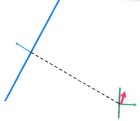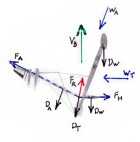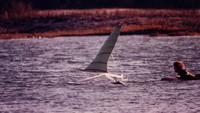High-Speed Sailing
| Vessel Name: | Sailien |
| Vessel Make/Model: | Experimental/custom |
28 September 2013
The America’s Cup
I watched, with interest, the videos of the 34th America’s Cup. At last we have fast sailboats engaged in a competition that is fun to watch. The virtual images (such as course boundaries, distance grid lines, separation between boats, etc.) overlaid on the real images really helps to keep the race [...]
31 August 2013
100 Knots for Hydroptere?
The latest news from Hydroptere is that they have plans for a 100 knot sailboat. This was posted on 26 Aug 2013, so look for that date at this address. http://hydroptere.com/en/the-news/last-news/
17 November 2012
Aptly named Sailrocket, blasts off!
While yet to be ratified, Sailrocket posted an average speed over 500 meters of 59 knots. I will not be surprised if they increase their record into the 60 knot range during this record attempt.
02 January 2012
More drag for VSR2?
I want to start by pointing out that the whole VSR2 team has done a stellar job and has demonstrated conclusively that the forces that drive a sailboat can be aligned for roll stability without using ballast and without using any down-force. (Trifoiler achieved roll stability by using down-force, but [...]
18 December 2011
My analysis of Sailrocket
I copied a diagram of VSR2 (wing doesn’t show well) and added in the major force arrows that apply. Be aware that these arrows are not correct in terms of scale (length) and some of their locations are guesses, however I believe I’m correct enough for us to learn something about what VSR2 has been [...]
23 October 2011
60 is within reach, what’s next?
I have been watching Sailrocket’s progress with great interest and there’s no question they have a winner. I fully expect to see them reach 60kt in the near future. Sailrocket has now demonstrated what I first learned with my models and again with my full-sized prototypes, that if you get the forces [...]
Patents
The patent system was not and is not designed to reward inventors as its primary purpose. The purpose of the patent system is to provide the public (everyone) with a technology data base. Some wise person (check patent history) understood that if the country had a good technology data base, the whole country would benefit. The patent system was set-up to entice inventors to publish their invention for the good of all. The "carrot" was to grant the inventor a monopoly on the invention for a period of time (20years - sort of). At the end of that time the inventor's exclusive rights expire and the patent is public domain. Any invention that's passed its expiration date is yours to use in any way you wish, it's totally free to you and you can make the invention described and sell it.
People talk about big corporations buying up a competing patent and shelving it. This does happen but it only works for the life of the patent, at which time anyone can manufacture and sell the invention.
Another misconception is that the govt. will defend your patent rights; it won't. If someone infringes your patent, you get to sue them and attempt to prove in court that they are infringing on your patent rights. It's the usual legal battle with attorneys splitting legal "hairs" and words. It does, however give you a fighting chance (at your expense).
Here is how you can find any US patent: First, don't bother with any patent service except the US Patent and Trademark Office. It's all there, it's all free, and it's all available on line. (Yes you can print out any patent, free even if it's still in force.) You can instantly find any patent, if you know the number. You can also find all patents by any inventor by searching his/her name. You can also search by subject etc. Note that the patent office says "full text since 1976, full page images since 1790". What this means is the later patents show up as a text document (no drawings) but all the patents (complete text and drawings) can be viewed and copied, but require a TIFF reader.
Here goes: to find my sailboat patent (I also have a disrelated patent) go to: www.uspto.gov
On the left side of screen, click "Patents", in drop down box, click "search patents", next screen, left box "Issued Patents", click "patent number search", next screen enter whatever US patent # you want, click "search" and you'll get it. My sailboat patent is 5113775 you will get the whole text of the patent but no drawings. To get the drawings click the box "images" (it's above in the center) you will get the first page of the patent (note this is in TIFF format, you will need a reader, if you don't have one on your computer. If you need a reader search in help, USPTO lists two, choose AlternaTIFF, it's free, it works great - I use it) To get the next page etc, click the buttons on the left of the screen. To print the page, use the printer symbol on the TIFF page, not the one in your browser.
I've advanced well beyond what's shown in the patent, but the model and full-sized prototype it's based on, sailed well on all points of sailing. In fact, I sailed the model in about 30 knots of wind once, it was stable and fully controllable, until the main strut broke (it stood about 5 feet tall and weighed about 7 pounds.
Note that my contact info in the patent is no longer valid.
Bob
About & Links
- Bob's Surfing Blog
- Bob's Website
- Greenbird (Windjet)
- l'Hydroptere
- Le Projet Dared
- Macquarie Speed Sailing Team
- Monofoil Sailing
- Mountain Goat STOL
- Mr Smith's Amazing Sailboats
- Patent Office (Search)
- Radboat
- Sailien Prototypes (early), Delta, etc.
- Sailien Video
- Sailien Website
- The Basics of Surfboard Design
- The Basics of Surfboard Design en Espanol
- The Swedish Speed-Sailing Challenge
- Trifoiler
- Vestas Sailrocket
- Windjet Project
- WSSRC


